

No. 44 (Royal Marine) Commando. No. 44 (Royal Marine) Commando was a battalion size formation in the British Commandos, formed during the Second World War.
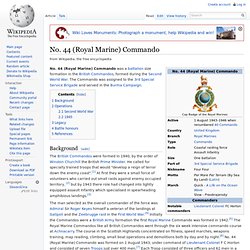
The Commando was assigned to the 3rd Special Service Brigade and served in the Burma Campaign. The British Commandos were formed in 1940, by the order of Winston Churchill the British Prime Minister. He called for specially trained troops that would "develop a reign of terror down the enemy coast".[1] At first they were a small force of volunteers who carried out small raids against enemy occupied territory, [2] but by 1943 there role had changed into lightly equipped assault Infantry which specialised in spearheading amphibious landings.[3] 40 Commando. 40 Commando RM is a battalion sized formation of the British Royal Marines and subordinate unit within 3 Commando Brigade, the principal Commando formation, under the Operational Command of Commander in Chief Fleet.
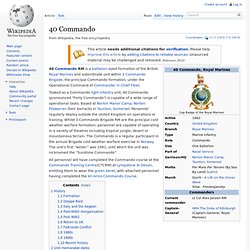
Tasked as a Commando light infantry unit, 40 Commando (pronounced "Forty Commando") is capable of a wide range of operational tasks. Based at Norton Manor Camp, Norton Fitzwarren their barracks in Taunton, Somerset. Personnel regularly deploy outside the United Kingdom on operations or training. Whilst 3 Commando Brigade RM are the principal cold weather warfare formation, personnel are capable of operating in a variety of theatres including tropical jungle, desert or mountainous terrain. 43 Commando Fleet Protection Group Royal Marines. The 43 Commando Fleet Protection Group Royal Marines (43 Cdo FP Gp RM),[3] formerly Comacchio Company Royal Marines (1980–1983), Comacchio Group Royal Marines (1983–2001) and Fleet Protection Group Royal Marines (2001-2012), is a 790 man unit of the Royal Marines responsible for guarding the United Kingdom's Naval nuclear weapons and other security-related duties.
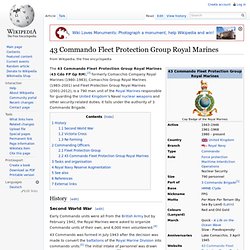
It falls under the authority of 3 Commando Brigade. History[edit] Second World War[edit] Early Commando units were all from the British Army but by February 1942, the Royal Marines were asked to organize Commando units of their own, and 6,000 men volunteered.[4] Along with No. 2, No. 9 and No. 40 (Royal Marine) Commandos they formed the 2nd Special Service Brigade.[9] Throughout the course of 1943–45, No. 43 (Royal Marine) Commando served in Italy, Yugoslavia and Greece.[10] Victoria Cross[edit] Re-forming[edit] In 2004, rifle squadron P was renamed S squadron and the Group was further expanded to a complement of 530. 42 Commando. 42 Commando Royal Marines (pronounced: "Four Two Commando") is a battalion sized formation of the British Royal Marines and a subordinate unit within 3 Commando Brigade, the principal Commando formation, under the Operational Command of Commander in Chief Fleet.

Tasked as a Commando unit, 42 Cdo RM is capable of a wide range of operational tasks. Based at Bickleigh Barracks near Plymouth, personnel regularly deploy outside the United Kingdom on operations or training. Whilst 3 Commando Brigade RM are the principal cold weather warfare formation, personnel are capable of operating in a variety of theatres including tropical jungle, desert or mountainous terrain. All personnel will have completed the Commando course at the Commando Training Centre(CTCRM) at Lympstone in Devon, entitling them to wear the green beret, with attached personnel having completed the All Arms Commando Course. History[edit] 45 Commando. 45 Commando Royal Marines (pronounced "four-five commando") is a battalion sized unit of the British Royal Marines and subordinate unit within 3 Commando Brigade Royal Marines, the principal Commando formation, under the Operational Command of Commander in Chief Fleet.
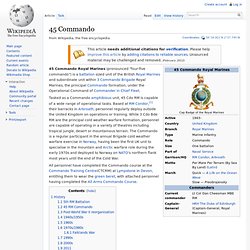
Tasked as a Commando amphibious unit, 45 Cdo RM is capable of a wide range of operational tasks. Based at RM Condor,[1] their barracks in Arbroath, personnel regularly deploy outside the United Kingdom on operations or training. While 3 Cdo Bde RM are the principal cold weather warfare formation, personnel are capable of operating in a variety of theatres including tropical jungle, desert or mountainous terrain.
United States Naval Special Warfare Development Group. The United States Naval Special Warfare Development Group (NSWDG), or DEVGRU, is a U.S.
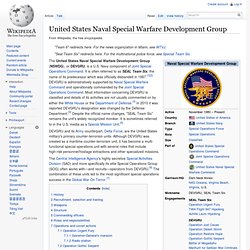
Navy component of Joint Special Operations Command. It is often referred to as SEAL Team Six, the name of its predecessor which was officially disbanded in 1987.[1][2] DEVGRU is administratively supported by Naval Special Warfare Command and operationally commanded by the Joint Special Operations Command. Most information concerning DEVGRU is classified and details of its activities are not usually commented on by either the White House or the Department of Defense.[3] In 2010 it was reported DEVGRU's designation was changed by the Defense Department.[4] Despite the official name changes, "SEAL Team Six" remains the unit's widely recognized moniker.
40 Commando.
List of air forces. Spanish aircraft carrier Príncipe de Asturias. The Príncipe de Asturias, originally named Almirante Carrero Blanco, is an aircraft carrier and was the flagship of the Spanish Navy.
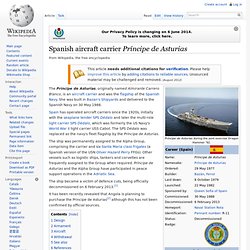
She was built in Bazan's Shipyards and delivered to the Spanish Navy on 30 May 1988. Spain has operated aircraft carriers since the 1920s, initially with the seaplane tender SPS Dédalo and later the multi-role light carrier SPS Dédalo, which was formerly the US Navy's World War II light carrier USS Cabot. Italian aircraft carrier Giuseppe Garibaldi (551)
For other ships of this name, see Italian ship Giuseppe Garibaldi Giuseppe Garibaldi is an Italian aircraft carrier, the first through deck aviation ship ever built for the Italian Navy, and the first Italian ship built to operate fixed-wing aircraft.
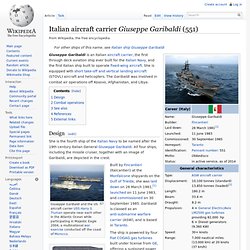
She is equipped with short take-off and vertical landing aircraft (STOVL) aircraft and helicopters. The Garibaldi was involved in combat air operations off Kosovo, Afghanistan, and Libya. JDS Hyūga (DDH-181) JDS Hyūga (DDH-181) is a Hyūga-class helicopter destroyer of the Japan Maritime Self-Defense Force (JMSDF).
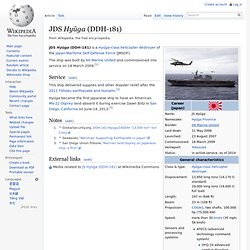
The ship was built by IHI Marine United and commissioned into service on 18 March 2009.[1] This ship delivered supplies and other disaster relief after the 2011 Tōhoku earthquake and tsunami.[2] Hyūga became the first Japanese ship to have an American MV-22 Osprey land aboard it during exercise Dawn Blitz in San Diego, California on June 14, 2013.[3]
Izumo-class helicopter destroyer. The Izumo-class helicopter destroyer (いずも型護衛艦, Izumo-gata-goei-kan?)

Or 22DDH is a type of new helicopter carrier class being constructed for the Japan Maritime Self-Defense Force (JMSDF). The ships of this class will be the largest surface combatants of the JMSDF, taking over the mantle currently held by the Hyūga-class helicopter destroyers. The lead ship was officially unveiled at Yokohama on 6 August 2013.[3] Construction[edit] Hyūga-class helicopter destroyer. The Hyūga's code-name (16DDH) and Ise's code-name (18DDH) derive from the Japanese calendar, specifically the 16th year and 18th year of the Heisei reign (2004 and 2006), when the provisional title was given.[1] Design and specifications[edit] The ships' primary mission is to function as an anti-submarine warfare carrier with her SH-60K anti-submarine helicopters. They also have enhanced command-and-control capabilities, allowing them to serve as flagships for the JMSDF.[1] During peacetime operations, or “military operations other than war” (MOOTW), the ships join the Ōsumi-class ships for peacekeeping and relief operations, as well as the “diverse situations” Japan foresees confronting on the high seas.
Afghan War order of battle. A U.S. Army Special Forces soldier scans for insurgents during an engagement on 10 April 2007, in the Sangin District area of Helmand Province in southern Afghanistan. (U.S. Army photo by Spc. Daniel Love). This list covers current coalition forces in Afghanistan. For coalition forces involved in NATO combat operations in the past, see the articles Coalition combat operations in Afghanistan in 2006, Coalition combat operations in Afghanistan in 2007, and Coalition combat operations in Afghanistan in 2008.
International Security Assistance Force[edit] Air Force Special Operations Command. 24th Special Tactics Squadron. The 24th Special Tactics Squadron is one of the Special Tactics units of the United States Air Force Special Operations Command (AFSOC). It is the U.S. Air Force component to Joint Special Operations Command.[1][2] It is garrisoned at Pope Field, North Carolina. Lineage[edit] Constituted as 24 Air Corps Interceptor Control Squadron on 14 October 1941. Activated on 21 October 1941. Redesignated as 24 Fighter Control Squadron on 15 May 1942. Disbanded on 31 March 1944. Reconstituted, and consolidated (1 March 1992) with the 1724 Combat Control Squadron which was designated, and activated, on 1 May 1987.Redesignated as: 1724 Special Tactics Squadron on 1 October 1987.Redesignated as: 24 Special Tactics Squadron on 31 March 1992. Task Force 88 (anti-terrorist unit)
Since the invasion of Iraq, the unit went through a number of changes of designation. Task Force 20 was amalgamated with Task Force 5 (formerly Task Force 11/Task Force Sword) in Afghanistan in July 2003, and became Task Force 21. It was then redesignated Task Force 121, and later as Task Force 626, Task Force 145, and Task Force 88.[6] Neville notes that he omitted the 'current' (c.2008, time of writing) designation of the unit. SEAL Team Six. Naval Special Warfare Group 3. Naval Special Warfare Group 3 (NSWG-3), based at the Naval Amphibious Base Coronado in California, is one of six constituent formations of the United States Naval Special Warfare Command.[1] Until 2008, NSWG-3 was composed of two SEAL Delivery Vehicle Teams: SDVT-1 in Pearl Harbor and SDVT-2 in Little Creek. In 2008, SDVT-2 was disestablished and merged into SDVT-1, which is now headquartered in San Diego and operates detachments in Pearl Harbor and Little Creek.
SDV Teams are SEAL teams with an added underwater delivery capability. An SDV platoon consists of 12-15 SEALs. Germany: Navy appoints first female submarine officer. 3 April 2014Last updated at 10:48 ET. United States Navy Reserve. Is not available. Staff College, Camberley. Staff College, Camberley, Surrey, was a staff college for the British Army from 1802 to 1997, with periods of closure during major wars. In 1997 it was merged into the new Joint Services Command and Staff College. Royal Naval College, Greenwich. New Zealand Defence College. The New Zealand Command and Staff College (NZCSC) is the premier educational institute for the New Zealand Defence Force (NZDF) and is located at Trentham Military Camp, Upper Hutt (near Wellington).
The New Zealand Command and Staff College provides professional military education to New Zealand Defence Force officers which prepares officers for command and staff appointments. Eurocopter EC725. The Eurocopter EC 725 Caracal (also named Super Cougar) is a long-range tactical transport helicopter developed from the Super Puma/Cougar family for military use.
It is a twin-engined aircraft and can carry up to 29 seated troops along with two crew, depending on customer configuration. The helicopter is marketed for troop transport, casualty evacuation, and combat search and rescue duties, and is similar to the civilian EC 225. Development[edit] The EC 725 was developed to meet a French Air Force requirement for a specialist helicopter for Combat Search & Rescue operations after the AS 532 A2 Cougar model was rejected for this purpose following extensive trials between 1996 and 1999. Naval Station Rota Spain. Naval Station Rota, also known as NAVSTA Rota, (IATA: ROZ, ICAO: LERT) (Spanish: Base Naval de Rota), is a Spanish naval base commanded by a Spanish Rear Admiral and fully funded by the United States of America.[1] Located in Rota in the Province of Cádiz, near the town of El Puerto de Santa María, NAVSTA Rota is the largest American military community in Spain and houses US Navy and US Marine Corps personnel.
Spanish aircraft carrier Príncipe de Asturias. Spanish ship Juan Carlos I (L61) Sikorsky SH-3 Sea King. GAU-12 Equalizer. Lockheed AC-130. Fridtjof Nansen-class frigate. AN/SLQ-25 Nixie. McDonnell Douglas AV-8B Harrier II. Royal Naval College, Greenwich. Britannia Royal Naval College. Canadian Forces College. Bundesakademie für Sicherheitspolitik. Führungsakademie der Bundeswehr. Goh Keng Swee Command and Staff College. Naval War College. Canadian Army Command and Staff College. Defence Academy of the United Kingdom. Joint Services Command and Staff College. RAF Staff College, Bracknell. Royal College of Defence Studies. Astute-class submarine. Virginia-class submarine. Operation Herrick.
South African Navy. South African National Defence Force. South African Air Force. Old Royal Naval College. South African Military Health Service. South African Army. French aircraft carrier Charles de Gaulle (R91) Arleigh Burke-class destroyer. Italian aircraft carrier Cavour (550) Dassault-Breguet Super Étendard. Eurocopter AS532 Cougar. Eurocopter AS365 Dauphin. Northrop Grumman E-2 Hawkeye. Dassault Rafale. United States Navy SEALs.